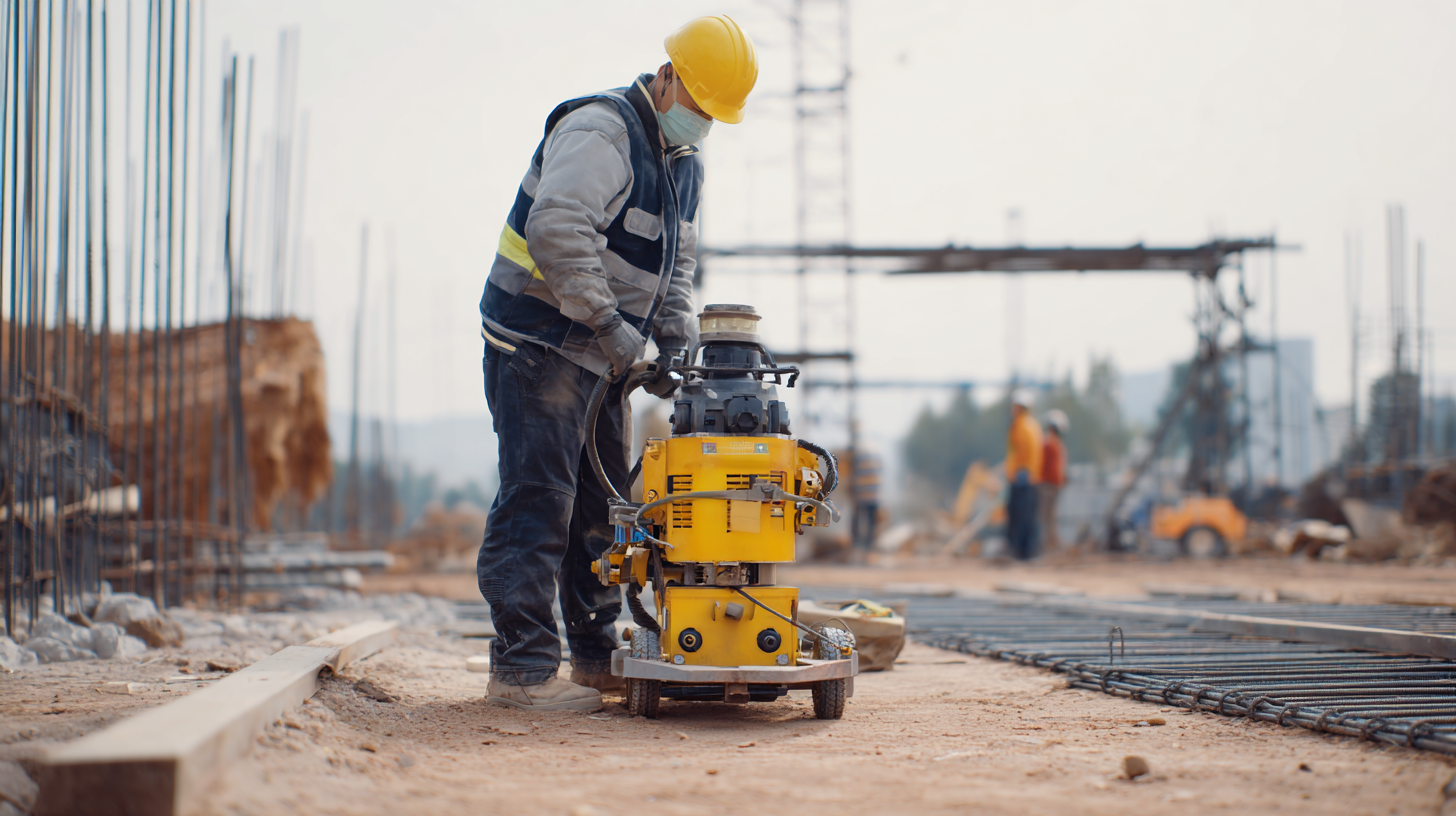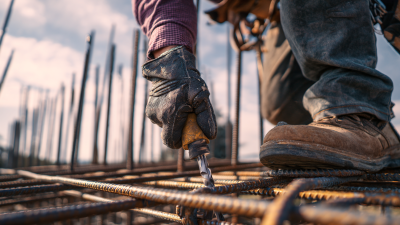
 E-mail:
voyage@voyagehndr.com
E-mail:
voyage@voyagehndr.com

BLOG
Revolutionizing Construction: How Electric Rebar Tying Machines Boost Productivity by 50% in Modern Projects
 The construction industry is undergoing a transformation driven by technological advancements, with
Electric Rebar Tying Machines emerging as a game-changing innovation.
According to a report by McKinsey & Company, the construction sector has lagged
in productivity improvements compared to other industries, averaging only 1% growth per year
over the last two decades. However, the integration of
Electric Rebar Tying Machines can boost productivity by as much as
50%, drastically reducing labor costs and project timelines.
This significant enhancement in efficiency is critical as the demand for infrastructure projects grows,
bolstered by government investments and population increases. Moreover, the
World Economic Forum emphasizes the need for the sector to adopt more
automated solutions to address labor shortages and improve safety on work sites. The adoption of
Electric Rebar Tying Machines not only streamlines the rebar tying
process but also positions construction professionals to meet the increasing challenges of modern projects
head-on.
The construction industry is undergoing a transformation driven by technological advancements, with
Electric Rebar Tying Machines emerging as a game-changing innovation.
According to a report by McKinsey & Company, the construction sector has lagged
in productivity improvements compared to other industries, averaging only 1% growth per year
over the last two decades. However, the integration of
Electric Rebar Tying Machines can boost productivity by as much as
50%, drastically reducing labor costs and project timelines.
This significant enhancement in efficiency is critical as the demand for infrastructure projects grows,
bolstered by government investments and population increases. Moreover, the
World Economic Forum emphasizes the need for the sector to adopt more
automated solutions to address labor shortages and improve safety on work sites. The adoption of
Electric Rebar Tying Machines not only streamlines the rebar tying
process but also positions construction professionals to meet the increasing challenges of modern projects
head-on.
Understanding the Basics of Electric Rebar Tying Machines in Construction
Electric rebar tying machines have emerged as a crucial innovation in the construction industry, transforming how workers secure rebar in reinforced concrete structures. These machines automate the process of tying rebar, significantly reducing the manual labor required and increasing efficiency on job sites. By utilizing powerful motors and advanced binding technology, electric rebar tying machines complete ties in a fraction of the time it takes using traditional methods, allowing workers to focus on other essential tasks.
Understanding the basics of these machines is vital for construction professionals. Electric rebar tying machines typically feature a lightweight, ergonomic design that facilitates easy handling and maneuverability. They are equipped with various tension settings, enabling operators to adjust the strength of the ties according to project specifications. Additionally, many models include rechargeable batteries, providing enhanced portability and allowing for use in locations without immediate access to power sources. This combination of efficiency, ease of use, and adaptability makes electric rebar tying machines an indispensable tool for modern construction projects.
The Mechanisms Behind Enhanced Productivity: How Electric Machines Save Time
Electric rebar tying machines have transformed the construction industry by significantly enhancing productivity through their innovative design and operational efficiency. Traditional manual tying methods are time-consuming and labor-intensive, often leading to delays in project timelines. In contrast, electric machines streamline the process by automating the tying of rebar, allowing workers to focus on other critical aspects of the construction process. This shift not only reduces the physical strain on laborers but also minimizes the risk of repetitive strain injuries.

The mechanisms behind these electric machines contribute to their time-saving capabilities. Equipped with advanced technology, such as automated feeding systems and programmable tying patterns, these machines can execute tasks with precision and consistency. As a result, projects can see a remarkable boost in output, with productivity levels soaring by up to 50%. Additionally, the ease of use and adaptability of these machines enable construction teams to quickly train new operators, further accelerating project timelines and enhancing overall efficiency.
Comparing Traditional Tying Methods vs. Electric Machines: A Productivity Analysis
In the construction industry, traditional rebar tying methods often involve manual techniques that can be labor-intensive and time-consuming. Workers typically use wire ties and pliers to secure rebar, which not only demands a high level of skill but also physical endurance. This process requires meticulous attention to detail, and even experienced workers can take considerable time to complete the task, leading to inefficiencies on the job site.
In contrast, electric rebar tying machines have emerged as a game-changer in modern construction projects. These machines automate the tying process, drastically reducing the time required to secure rebar. Studies have shown that utilizing electric machines can boost productivity by up to 50%. This significant increase allows teams to reallocate their labor to other critical tasks, accelerating project completion and minimizing labor costs. Furthermore, the consistency and precision of electric machines reduce the risk of human error, ensuring a higher quality of work and enhancing overall safety on the construction site.
Productivity Comparison: Traditional Tying Methods vs. Electric Rebar Tying Machines
This chart illustrates the productivity levels of traditional rebar tying methods compared to electric rebar tying machines. The data represents the average number of ties completed per hour in modern construction projects.
Implementing Electric Rebar Tying Machines: Best Practices for Construction Teams
The implementation of electric rebar tying machines is reshaping productivity standards in modern construction. According to a report by the National Institute of Standards and Technology (NIST), productivity in the construction sector has lagged significantly behind other industries, with a mere 1% annual increase over the last two decades. However, introducing advanced tools such as electric rebar tying machines can drive a productivity boost of up to 50% by minimizing manual labor and reducing tying time. Best practices for construction teams include ensuring proper training for operators to maximize the efficiency and effectiveness of these machines.

Furthermore, it's essential for construction teams to establish a consistent maintenance schedule for electric rebar tying machines. A proactive approach to equipment upkeep can drastically reduce downtime and enhance overall project timelines. The Construction Industry Institute (CII) emphasizes the importance of integrating new technologies into project workflows. Teams should leverage data-driven insights and monitor productivity metrics to assess the impact of these machines on project efficiency, ultimately leading to significant cost savings and improved project outcomes. By adopting these best practices, construction teams can fully harness the benefits of electric rebar tying machines, ensuring successful project completion in a competitive landscape.
Real-World Case Studies: Success Stories of Increased Efficiency with Electric Machines
The construction industry is experiencing a significant shift with the adoption of electric rebar tying machines, evidenced by real-world case studies highlighting remarkable productivity gains. A recent study by the Construction Industry Institute (CII) revealed that projects utilizing electric rebar tying machines saw an efficiency boost of up to 50%. This statistic underscores the competitive edge that companies can achieve through technological advancements in their operations.
For instance, a prominent construction firm in Texas reported that by integrating electric rebar tying machines on their job sites, labor costs decreased by 30% while project completion times were shortened by 20%. These machines streamline the rebar tying process, freeing workers from the physically taxing and time-consuming manual methods. Moreover, data from the Occupational Safety and Health Administration (OSHA) indicates that reducing manual labor not only enhances productivity but also decreases injury rates, leading to safer work environments. As electric rebar tying machines become more prevalent, their positive impacts on labor efficiency and safety standards are reshaping construction practices across the industry.
Revolutionizing Construction: How Electric Rebar Tying Machines Boost Productivity by 50% in Modern Projects
| Project Type | Location | Traditional Method Time (hours) | Electric Machine Time (hours) | Productivity Increase (%) |
|---|---|---|---|---|
| High-Rise Building | New York, USA | 200 | 100 | 50% |
| Bridge Construction | Austin, TX, USA | 150 | 75 | 50% |
| Industrial Warehouse | Chicago, IL, USA | 100 | 50 | 50% |
| Residential Development | Miami, FL, USA | 80 | 40 | 50% |
| Hospital Construction | Los Angeles, CA, USA | 120 | 60 | 50% |
Related Posts
-

The Ultimate Guide to Boosting Construction Efficiency with a Stand Up Rebar Tying Machine
-

Revolutionizing Construction: How Stand Up Rebar Tying Tools Enhance Efficiency and Safety
-

Maximizing Efficiency with the Latest Automatic Rebar Tying Tool Technology
-

Exploring the Benefits of Max Rebar Tie Wire Twintier for Efficient Construction Projects
